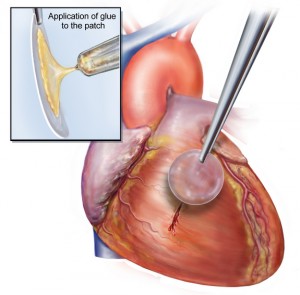Ever watched the TV show Star Trek, where Captain Jean-Luc Picard is stabbed in the heart but yet survives due to a device that stitches wounds in the heart? Now, researchers have found an adhesive of similar function where rather than using stitches or staples, this glue repairs heart wounds which are as strong as the alternatives while avoiding complicated procedures.
Inventors, Jeffrey M. Karp, an associate professor of medicine at Harvard Medical School, andDr. Pedro del Nido, a cardiac surgeon at Boston Children’s Hospital explains how staples and stitches can cause problems. Each pass of a suture (stich) needle, the tissue needs to be realigned and staples can damage the tissue and moreover, it requires the process of removal. In order to solve these problems, the researchers aimed to design a water-repellent glue that could harden quickly and create a seal that could withstand the stress in a beating heart.
The liquid glue is applied either on a patch and then placed on to the hole in the tissue (shown below) or directly to the tear of the blood vessel or the intestinal wall until the glue is hardened.
The surgeon then shines ultraviolet light onto the glue which results in a rubbery substance that merges with the heart’s collagen due to the glue molecules binding with the collagen fibres creating strong chains.
This adhesive has been tested on rats and pigs and have successfully shown that it helps seal the wound quicker than other adhesives that exist. In addition, “some of those adhesives require that the tissue be dried for the adhesive to stick, while others aren’t compatible with certain types of tissue,” Karp says.
Human trials are still necessary in order for use in the clinic but the researchers are optimistic that they will be able to utilize this in Europe by the end of 2015.
– Yuri Tomura



